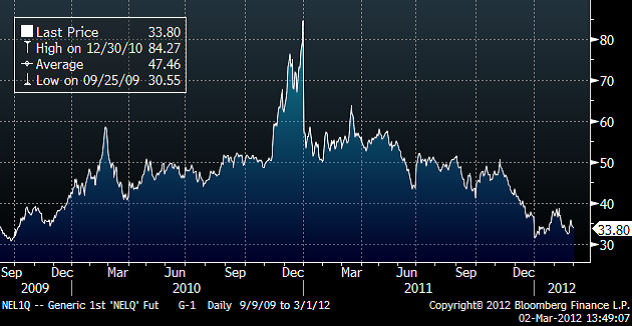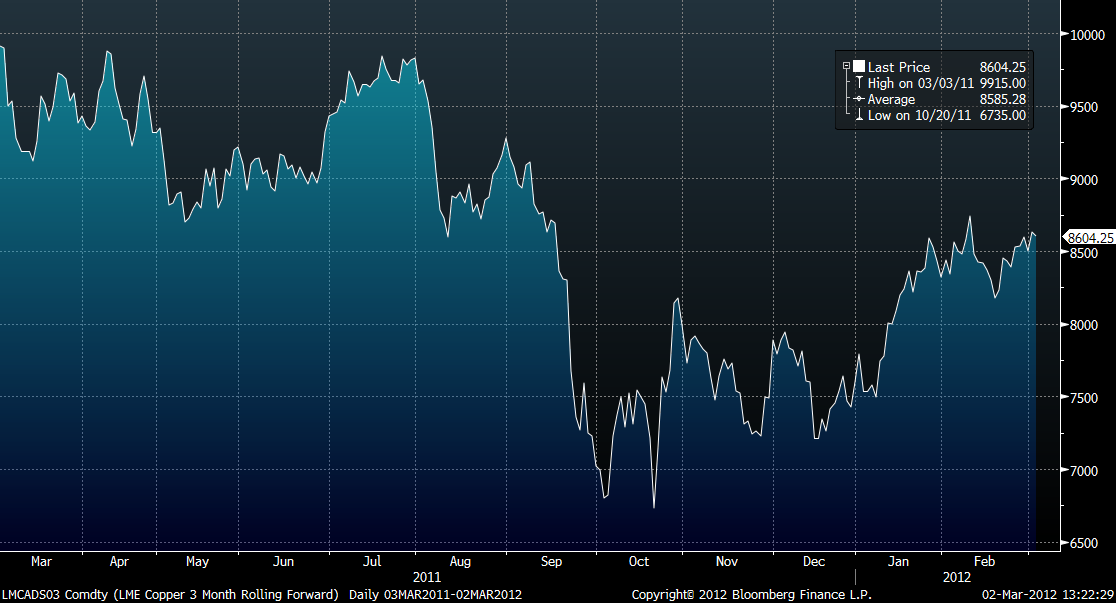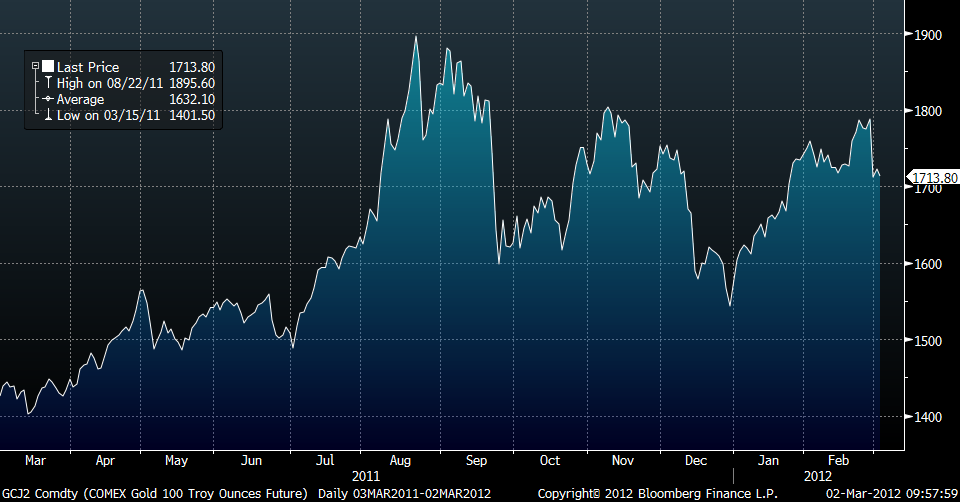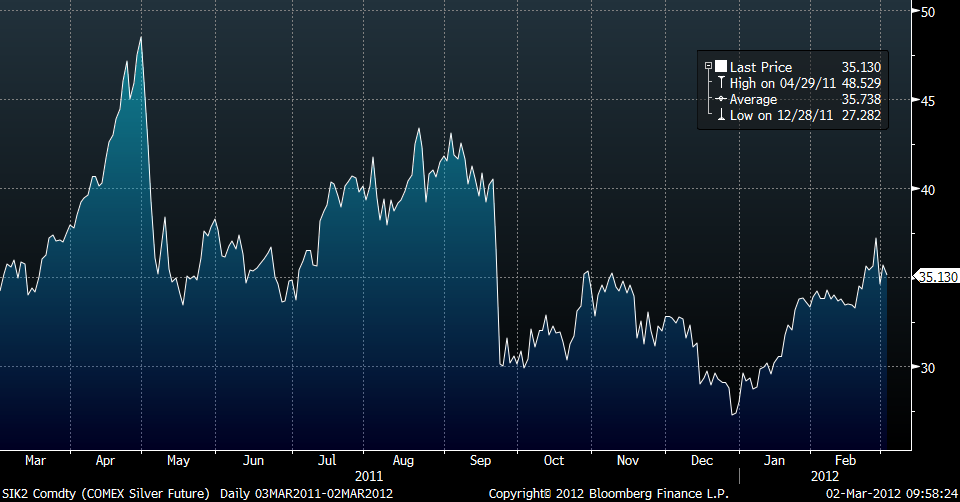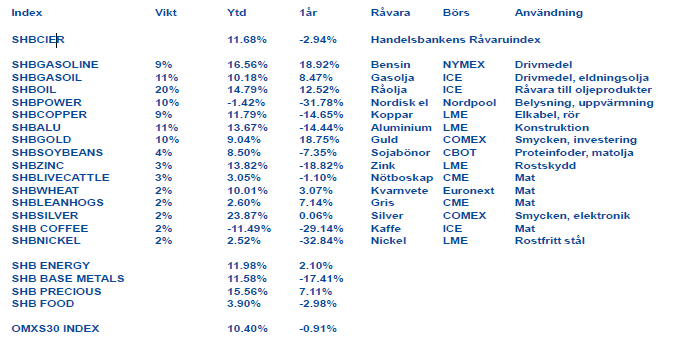Analys
SHB Råvarubrevet 2 mars 2012
 Våra vyer:
Våra vyer:
- Energi: Positiv
- Basmetaller: Positiv
- Ädelmetaller: Negativ
- Livsmedel: Neutral till Positiv (negativ på vete)
I onsdags kom den Europeiska centralbanken med LTRO2, en repa som ger cirka 300mdr nytryckta EUR som nu skvalpar omkring och överlikvidiserar eurosystemet i än högre grad än tidigare. Svallvågorna kommer att märkas i alla likviditetsdrivan tillgångar. Vi har rekommenderat vår basmetallkorg som en bra position för denna aktion. USA:s ekonomi ser ut att stå på en stabilare grund i ljuset av de senaste revideringarna av data under veckan, det sämre inköpschefsindexet till trots. Den Europeiska kalendern innehåller som vanligt flera potentiella oroshärdar men arbetsmarknadsdata talar för ytterligare räntesänkningar från ECB.
Vi förväntar oss alltså fortsatt tryck uppåt på råvaror av alla de slag: banker som valt att delta i den senaste LTRO:n använder inte den nya likviditeten direkt. Snarare bör man tala om en gradvis process som ger stöd under de kommande veckorna.
I USA har förväntningarna på ytterligare stimulanser dämpats efter Bernankes tal i onsdagskväll att Fed skulle sjösätta QE3 i en miljö med förbättrade konjunkturutsikter och stigande inflationsförväntningar framstod för oss som osannolikt. Guld och silver hade dock prisat in mer QE och föll båda skarpt på beskedet.
Det oväntade fallet i amerikanska inköpschefsindex ISM för tillverkningsindustrin skapar viss oro för tillväxtutsikterna. Vi tror dock att det är för tidigt att dra några större växlar av detta, bland annat då ISM har överskattat tillväxten rejält de senaste åren, hursomhelst så stiger spänningen kring konjunkturen i USA. Empiriskt sett tenderar även bensinpriset att påverka finansiella marknader negativt med en fördröjning på 13-22 veckor. Även detta är något att hålla ett öga på under våren. Ryktesvågen skapad av att iransk tv rapporterat att en pipeline i Saudi skulle ha sprängts har fått oljan att skena och späder på konjunktur-oron kring höga oljepris.
Energi (positiv)
Olja
Oljepriset (Brent) steg kraftigt under torsdagen och passerade 128 USD/fat efter iranska medier rapporterade om en oljeledning som exploderade i Saudi Arabien. Detta förnekades senare av Saudi Arabiska representanter vilket fick oljepriset att falla tillbaka. Under fredag eftermiddag handlades aprilkontraktet för 124,7 USD/fat vilket var 0,7 % lägre än förra veckan. Flera källor rapportera nu att sanktionerna mot Iran börja få effekt. Enligt Wall Street Journal har asiatiska rederier slutat använda vissa passager till Iran.
USA:s råvarulager steg till 4,2 miljoner fat (väntat 1,1 miljoner fat) medan destillat lagren sjönk med 2,1 miljoner (väntat 0,3 miljoner fat). Bensin lagren sjönk med 1,6 miljoner fat (väntat 0,3 miljoner fat).
Elmarknaden (neutral)
Elmarknaden har försvagats något ytterligare under veckan då vädret är fortsatt milt och vått. Väderprognoserna är dessutom både varmare och blötare än normalt vilket resulterat i att kontraktet Q2 2012 tappat lite drygt 1.5 procent och handlas nu under 34 euro per MWh.
De senaste prognoserna pekar på nederbörd om mellan 3.3 och 7.2 TWh, ca 25 procent över normalt för perioden, men lösningarna på slutet är extrema vilket innebär en stor osäkerhet mot nästa helg. Ser vi till energibalansen skulle det innebära en förbättring om ca 2.5 TWh till ett totalt överskott om ca 9.5 TWh efter vecka 10. Inga stora förändringar vad gäller kärnkraften men ett visst bortfall av produktion, Ringhals 2 har en felande ventil och Oskarshamn 1 har skador på turbinen, både förväntas dock vara tillbaka inom 10-12 dagar. Efterfrågan på energikol är låg till följd av det varma vädret. API2 kontraktet handlas fortsatt över 100 dollar men det höga oljepriset har inte fått någon effekt på kolet utan det ser snarare ut som om den svaga spotmarknaden på kol kan komma att pressa de något längre kolkontrakten ytterligare. Detta kommer att påverka elpriset negativt. Flertalet faktorer pekar nedåt men elmarknaden håller upp förhållandevis väl vilket gör att vi förväntar oss sidledes rörelser på el de kommande dagarna. Om prognoserna slår om under helgen och tappar delar av nederbörden mot slutet bör vi kunna se 1-2 euro rörelse upp på Q2 2012, om kolmarknaden däremot viker ner under 100 dollar kan vi komma att tappa 1-2 euro på Q2 2012.
Basmetaller (positiv)
Basmetallerna stänger veckan med blandat resultat, upp för samtliga metaller förutom nickel och bly som föll med 2,5 % respektive 1,5 %. Året har börjat starkt för metallerna samtidigt som lagernivåerna fortsatt att stiga på både i Kina och LME. I och med ECB:s LTRO2 finns det dock anledning att tro på stigande priser på basmetaller.
Kopparpriset har rört sig i intervallet 8 530 till 8 630 USD under veckan. Uppgången slutade på totalt knappt 1 % och uppgången sedan årets början har varit 10.5 %. Den ekonomiska återhämtningen i Asien (framförallt Kina och Indien) och USA fortsätter, vilket understödjer priset på den röda metallen. Lagren hos LME är fortsatt låga (289 000 ton, vilket också är den lägsta nivån sedan augusti 2009). Order för att ta ut mer metall är samtidigt på 8-årshögsta.
Vi är fortsatt positiva till kopparpriset. Förutom den positiva ekonomiska utvecklingen ser vi också tilltagande problem med att få fram högvärdig koppar ur gruvorna. Vi har läst rapporter från Rio Tinto (ett av världens största gruvbolag) om att deras kopparproduktion föll 23 % förra året, nästan enbart på grund av lägre kopparhalt i malmen.
Ädelmetaller (negativ)
Guld har haft en volatil vecka med relativt kraftiga intradagrörelser. Veckan slutade dock med en nedgång på 3.5%, vilket var den största veckovisa nedgången under 2012. Guldet har gått upp drygt 7 % sedan årsskiftet. Huvudförklaringen till denna veckas nedgång är dollarns styrka, vilket i sin tur beror på att Federal Reserve inte indikerade några ytterligare kvantitativa lättnader. Guldpriset gynnas av låga räntor (vilket kvantitativa lättnader möjliggör), då alternativkostnaden att hålla guld blir lägre. Vår grundsyn till guldpriset är fortfarande negativ. Vi är försiktigt positiva till hur ekonomin kommer utvecklas framöver, vilket kommer sätta stopp för alternativt dämpa den globala räntenedgången. Dessutom har vi vid flera tillfällen pekat på bubbeltendenser i guldpriset. Värt att notera är att guldet har stigit 11 år i rad.
Även silver har haft en volatil vecka, men nedgången blev blygsamma 0.8%. Uppgången under 2012 kan summeras till 19 %, vilket är den största uppgången av alla ädelmetaller. Silverpriset har gått ned mindre relativt guldet och vi anser att anledningen bakom det är att silvret ses som en industriell metall. Silverpriset har även funnit stöd från rapporter om stora nettoinflöden i ETF:er (Exchange Traded Funds). Vi intar en negativ hållning till silver, trots vår tro om en positiv utveckling av världsekonomin. Framförallt tror vi att en starkare dollar kommer påverka silverpriset i negativ riktning.
Livsmedel (neutral till positiv)
Vete (negativ)
Terminspriser på vete noteras högre i både Paris och Chicago sedan förra veckan, delvis som följd av rapporter om utvintringsskador i bland annat Frankrike och Tyskland – vilket nog ännu är för tidigt att göra en säker och korrekt bedömning om. Vädret är gynnsamt nu och i dagsläget finns ingen oro för ytterligare skador, detsamma gäller för Ryssland och Ukraina. Regn och snö har fallit i stora delar av USA vilket gynnat höstvetet, mer regn behövs men än så länge inga större skäl till oro. Vintern hämmar fortfarande den ryska exporten genom logistiska problem, det finns förmodligen gott om vete som ska säljas innan ny skörd ska in vilket kan pressa priserna lite längre fram. Höstvete tål ofta mycket mer än marknaden befarar och samtidigt bör marknaden reagera inte alltför starkt på bortfall då tillgången på vete är mer än god.
Majs
Majsen i Chicago har gått upp något i pris sedan förra veckan, påverkat bland annat av stigande priser på vete och råolja. I Argentina pekar väderprognoserna nu på fler regndagar än torra dagar fram till mitten av nästa vecka, vilket är bra för den sent sådda grödan men hindrar skörden av mogen gröda. Väderproblemet blir dock ett allt mindre problem ju närmare skördens avslut vi kommer och det finns i dagsläget inga skäl till ytterligare nedjusteringar, dock ligger USDA fortfarande något högt i sin prognos jämfört med flera privata analytiker i Sydamerika. Amerikanska majspriser bör kunna gå ned i pris om prognoserna om rekordhög areal faller in, men grödan ska först sås och visst stöd kommer ifrån rykten om ett ökat köpintresse från Kina.
Sojabönor
Sojapriserna i Chicago har stigit i pris sedan förra veckan, påverkat av stigande priser på råolja men även som följd av ökat intresse från Kina som köpt 175.000 ton av gammal skörd och 110.000 ton av kommande skörd från USA. Mer stöd till uppgången har kommit ifrån ytterligare nedjusteringar av den sydamerikanska skörden, flera privata lokala analytiker spår en skörd omkring 14 miljoner ton under förra årets, vilket dessutom är 7 miljoner ton under USDA:s nuvarande prognos. Uppgången har varit ganska långvarig nu och det krävs nog ytterligare nedjusteringar av den sydamerikanska skörden för att gå så mycket högre, samtidigt minskar möjligheterna för det ju närmare skördens avslut vi kommer.
Handelsbankens Råvaruindex
[box]SHB Råvarubrevet är producerat av Handelsbanken och publiceras i samarbete och med tillstånd på Råvarumarknaden.se[/box]
Ansvarsbegränsning
Detta material är producerat av Svenska Handelsbanken AB (publ) i fortsättningen kallad Handelsbanken. De som arbetar med innehållet är inte analytiker och materialet är inte oberoende investeringsanalys. Innehållet är uteslutande avsett för kunder i Sverige. Syftet är att ge en allmän information till Handelsbankens kunder och utgör inte ett personligt investeringsråd eller en personlig rekommendation. Informationen ska inte ensamt utgöra underlag för investeringsbeslut. Kunder bör inhämta råd från sina rådgivare och basera sina investeringsbeslut utifrån egen erfarenhet.
Informationen i materialet kan ändras och också avvika från de åsikter som uttrycks i oberoende investeringsanalyser från Handelsbanken. Informationen grundar sig på allmänt tillgänglig information och är hämtad från källor som bedöms som tillförlitliga, men riktigheten kan inte garanteras och informationen kan vara ofullständig eller nedkortad. Ingen del av förslaget får reproduceras eller distribueras till någon annan person utan att Handelsbanken dessförinnan lämnat sitt skriftliga medgivande. Handelsbanken ansvarar inte för att materialet används på ett sätt som strider mot förbudet mot vidarebefordran eller offentliggörs i strid med bankens regler.
Analys
Volatile but going nowhere. Brent crude circles USD 66 as market weighs surplus vs risk

Brent crude is essentially flat on the week, but after a volatile ride. Prices started Monday near USD 65.5/bl, climbed steadily to a mid-week high of USD 67.8/bl on Wednesday evening, before falling sharply – losing about USD 2/bl during Thursday’s session.

Brent is currently trading around USD 65.8/bl, right back where it began. The volatility reflects the market’s ongoing struggle to balance growing surplus risks against persistent geopolitical uncertainty and resilient refined product margins. Thursday’s slide snapped a three-day rally and came largely in response to a string of bearish signals, most notably from the IEA’s updated short-term outlook.
The IEA now projects record global oversupply in 2026, reinforcing concerns flagged earlier by the U.S. EIA, which already sees inventories building this quarter. The forecast comes just days after OPEC+ confirmed it will continue returning idle barrels to the market in October – albeit at a slower pace of +137,000 bl/d. While modest, the move underscores a steady push to reclaim market share and adds to supply-side pressure into year-end.
Thursday’s price drop also followed geopolitical incidences: Israeli airstrikes reportedly targeted Hamas leadership in Doha, while Russian drones crossed into Polish airspace – events that initially sent crude higher as traders covered short positions.
Yet, sentiment remains broadly cautious. Strong refining margins and low inventories at key pricing hubs like Europe continue to support the downside. Chinese stockpiling of discounted Russian barrels and tightness in refined product markets – especially diesel – are also lending support.
On the demand side, the IEA revised up its 2025 global demand growth forecast by 60,000 bl/d to 740,000 bl/d YoY, while leaving 2026 unchanged at 698,000 bl/d. Interestingly, the agency also signaled that its next long-term report could show global oil demand rising through 2050.
Meanwhile, OPEC offered a contrasting view in its latest Monthly Oil Market Report, maintaining expectations for a supply deficit both this year and next, even as its members raise output. The group kept its demand growth estimates for 2025 and 2026 unchanged at 1.29 million bl/d and 1.38 million bl/d, respectively.
We continue to watch whether the bearish supply outlook will outweigh geopolitical risk, and if Brent can continue to find support above USD 65/bl – a level increasingly seen as a soft floor for OPEC+ policy.
Analys
Waiting for the surplus while we worry about Israel and Qatar

Brent crude makes some gains as Israel’s attack on Hamas in Qatar rattles markets. Brent crude spiked to a high of USD 67.38/b yesterday as Israel made a strike on Hamas in Qatar. But it wasn’t able to hold on to that level and only closed up 0.6% in the end at USD 66.39/b. This morning it is starting on the up with a gain of 0.9% at USD 67/b. Still rattled by Israel’s attack on Hamas in Qatar yesterday. Brent is getting some help on the margin this morning with Asian equities higher and copper gaining half a percent. But the dark cloud of surplus ahead is nonetheless hanging over the market with Brent trading two dollar lower than last Tuesday.

Geopolitical risk premiums in oil rarely lasts long unless actual supply disruption kicks in. While Israel’s attack on Hamas in Qatar is shocking, the geopolitical risk lifting crude oil yesterday and this morning is unlikely to last very long as such geopolitical risk premiums usually do not last long unless real disruption kicks in.
US API data yesterday indicated a US crude and product stock build last week of 3.1 mb. The US API last evening released partial US oil inventory data indicating that US crude stocks rose 1.3 mb and middle distillates rose 1.5 mb while gasoline rose 0.3 mb. In total a bit more than 3 mb increase. US crude and product stocks usually rise around 1 mb per week this time of year. So US commercial crude and product stock rose 2 mb over the past week adjusted for the seasonal norm. Official and complete data are due today at 16:30.
A 2 mb/week seasonally adj. US stock build implies a 1 – 1.4 mb/d global surplus if it is persistent. Assume that if the global oil market is running a surplus then some 20% to 30% of that surplus ends up in US commercial inventories. A 2 mb seasonally adjusted inventory build equals 286 kb/d. Divide by 0.2 to 0.3 and we get an implied global surplus of 950 kb/d to 1430 kb/d. A 2 mb/week seasonally adjusted build in US oil inventories is close to noise unless it is a persistent pattern every week.
US IEA STEO oil report: Robust surplus ahead and Brent averaging USD 51/b in 2026. The US EIA yesterday released its monthly STEO oil report. It projected a large and persistent surplus ahead. It estimates a global surplus of 2.2 m/d from September to December this year. A 2.4 mb/d surplus in Q1-26 and an average surplus for 2026 of 1.6 mb/d resulting in an average Brent crude oil price of USD 51/b next year. And that includes an assumption where OPEC crude oil production only averages 27.8 mb/d in 2026 versus 27.0 mb/d in 2024 and 28.6 mb/d in August.
Brent will feel the bear-pressure once US/OECD stocks starts visible build. In the meanwhile the oil market sits waiting for this projected surplus to materialize in US and OECD inventories. Once they visibly starts to build on a consistent basis, then Brent crude will likely quickly lose altitude. And unless some unforeseen supply disruption kicks in, it is bound to happen.
US IEA STEO September report. In total not much different than it was in January
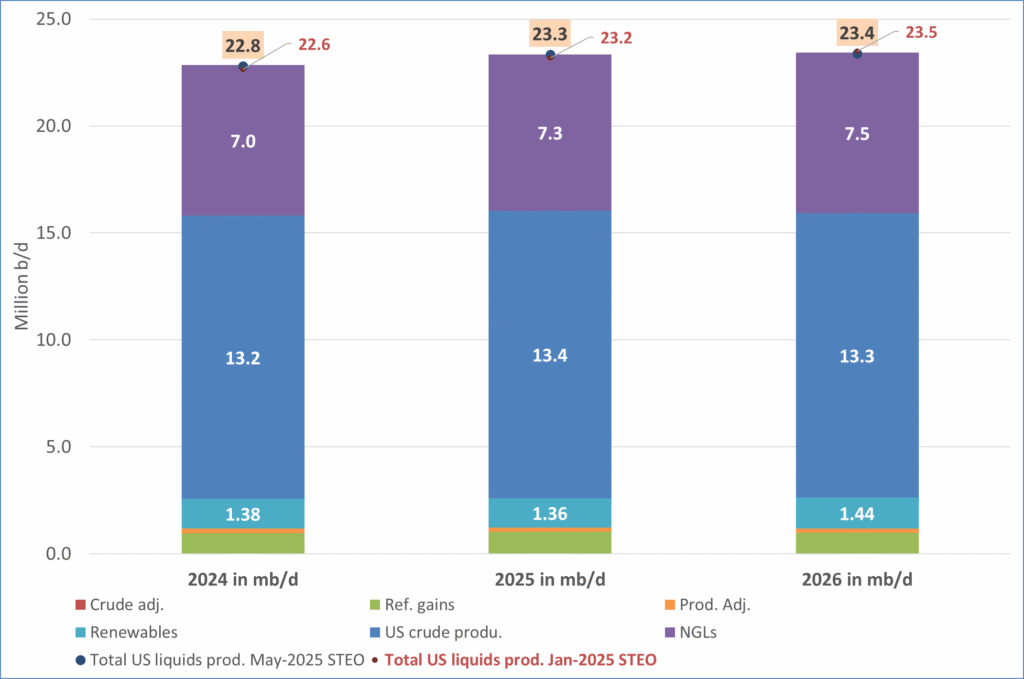
US IEA STEO September report. US crude oil production contracting in 2026, but NGLs still growing. Close to zero net liquids growth in total.
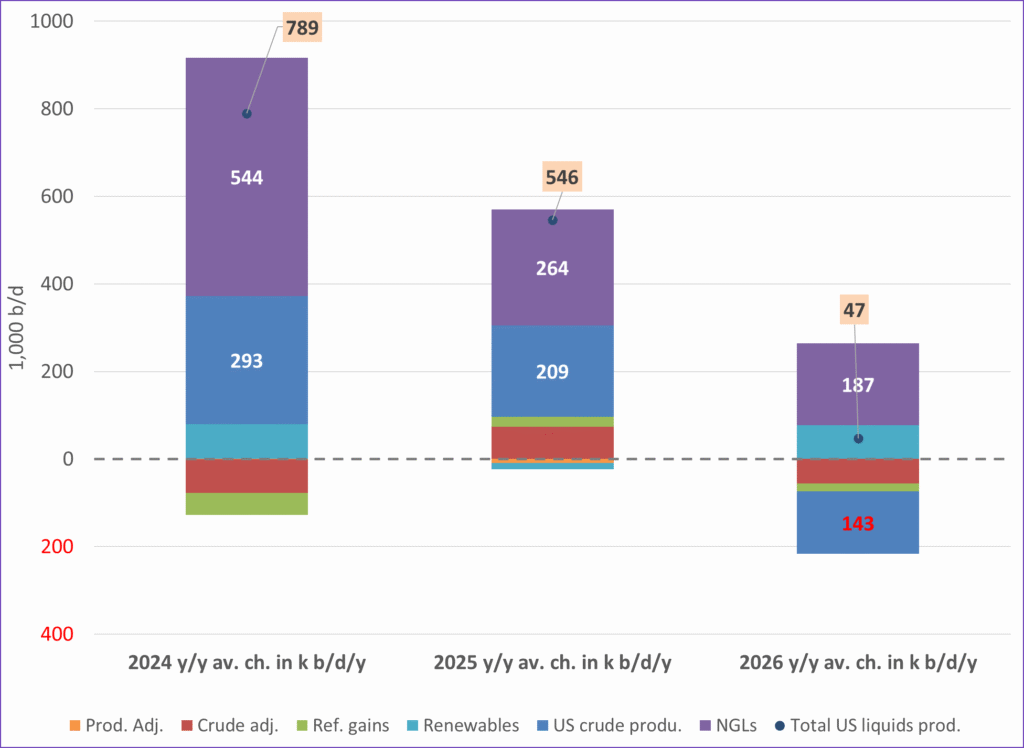
Analys
Brent crude sticks around $66 as OPEC+ begins the ’slow return’

Brent crude touched a low of USD 65.07 per barrel on Friday evening before rebounding sharply by USD 2 to USD 67.04 by mid-day Monday. The rally came despite confirmation from OPEC+ of a measured production increase starting next month. Prices have since eased slightly, down USD 0.6 to around USD 66.50 this morning, as the market evaluates the group’s policy, evolving demand signals, and rising geopolitical tension.

On Sunday, OPEC+ approved a 137,000 barrels-per-day increase in collective output beginning in October – a cautious first step in unwinding the final tranche of 1.66 million barrels per day in voluntary cuts, originally set to remain off the market through end-2026. Further adjustments will depend on ”evolving market conditions.” While the pace is modest – especially relative to prior monthly hikes – the signal is clear: OPEC+ is methodically re-entering the market with a strategic intent to reclaim lost market share, rather than defend high prices.
This shift in tone comes as Saudi Aramco also trimmed its official selling prices for Asian buyers, further reinforcing the group’s tilt toward a volume-over-price strategy. We see this as a clear message: OPEC+ intends to expand market share through steady production increases, and a lower price point – potentially below USD 65/b – may be necessary to stimulate demand and crowd out higher-cost competitors, particularly U.S. shale, where average break-evens remain around WTI USD 50/b.
Despite the policy shift, oil prices have held firm. Brent is still hovering near USD 66.50/b, supported by low U.S. and OECD inventories, where crude and product stocks remain well below seasonal norms, keeping front-month backwardation intact. Also, the low inventory levels at key pricing hubs in Europe and continued stockpiling by Chinese refiners are also lending resilience to prices. Tightness in refined product markets, especially diesel, has further underpinned this.
Geopolitical developments are also injecting a slight risk premium. Over the weekend, Russia launched its most intense air assault on Kyiv since the war began, damaging central government infrastructure. This escalation comes as the EU weighs fresh sanctions on Russian oil trade and financial institutions. Several European leaders are expected in Washington this week to coordinate on Ukraine strategy – and the prospect of tighter restrictions on Russian crude could re-emerge as a price stabilizer.
In Asia, China’s crude oil imports rose to 49.5 million tons in August, up 0.8% YoY. The rise coincides with increased Chinese interest in Russian Urals, offered at a discount during falling Indian demand. Chinese refiners appear to be capitalizing on this arbitrage while avoiding direct exposure to U.S. trade penalties.
Going forward, our attention turns to the data calendar. The EIA’s STEO is due today (Tuesday), followed by the IEA and OPEC monthly oil market reports on Thursday. With a pending supply surplus projected during the fourth quarter and into 2026, markets will dissect these updates for any changes in demand assumptions and non-OPEC supply growth. Stay tuned!
-

 Nyheter4 veckor sedan
Nyheter4 veckor sedanMeta bygger ett AI-datacenter på 5 GW och 2,25 GW gaskraftverk
-
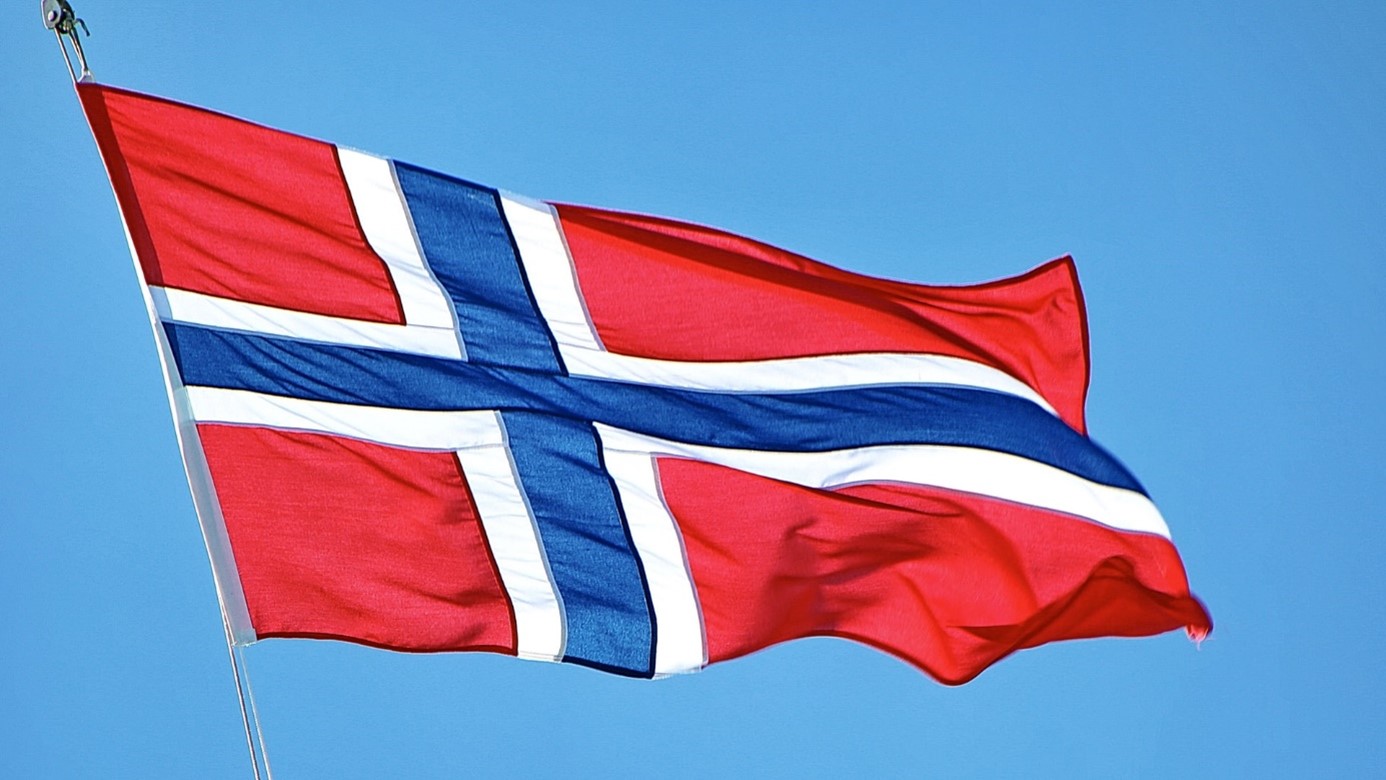
 Nyheter4 veckor sedan
Nyheter4 veckor sedanAker BP gör ett av Norges största oljefynd på ett decennium, stärker resurserna i Yggdrasilområdet
-

 Nyheter4 veckor sedan
Nyheter4 veckor sedanEtt samtal om koppar, kaffe och spannmål
-

 Analys4 veckor sedan
Analys4 veckor sedanBrent sideways on sanctions and peace talks
-

 Nyheter4 veckor sedan
Nyheter4 veckor sedanSommarens torka kan ge högre elpriser i höst
-

 Analys3 veckor sedan
Analys3 veckor sedanBrent edges higher as India–Russia oil trade draws U.S. ire and Powell takes the stage at Jackson Hole
-

 Nyheter3 veckor sedan
Nyheter3 veckor sedanMahvie Minerals är verksamt i guldrikt område i Finland
-

 Analys3 veckor sedan
Analys3 veckor sedanIncreasing risk that OPEC+ will unwind the last 1.65 mb/d of cuts when they meet on 7 September


